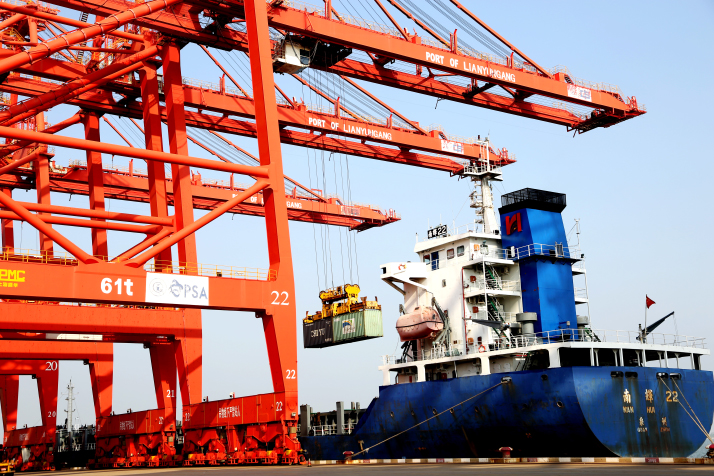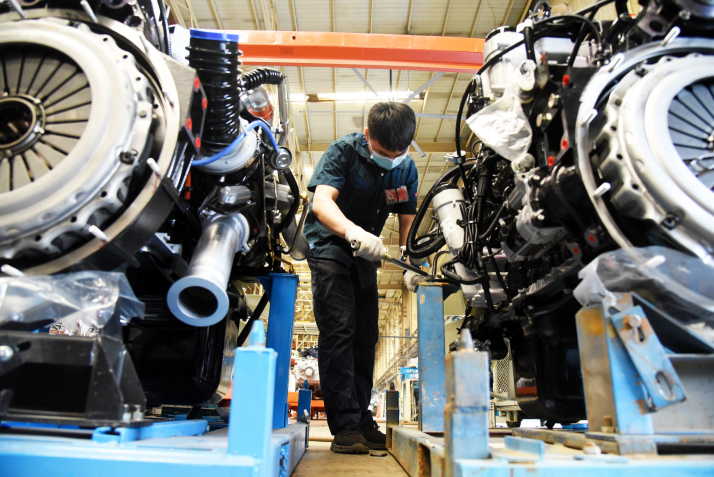| Business |
| Six new FTZs bring in results on their first anniversary | |
|
|
 Containers are loaded onto a steamship in the Port of Lianyungang, Jiangsu Province in east China, on September 7, to be exported overseas (XINHUA)
From the Caoqiao Subway Station in southwest Beijing, it takes only 20 minutes to get to the Beijing Daxing International Airport, which is located in the junction between Daxing District and Hebei Province. With this new state-of-the-art airport, which is part of the China (Hebei) Pilot Free Trade Zone (FTZ), the FTZ has become the latest test field for opening up in north China. According to Shen Jianmin, head of office for the Daxing Airport Area, with its unique advantages, including a comprehensive bonded zone, and Beijing's policy support for opening up the service sector, the FTZ has greater space for policy innovation in developing industries and attracting talents. "It can become an integrated innovation highland for reform and development," Shen told People's Daily. On August 26, 2019, the State Council approved six new pilot FTZs in six provinces: Shandong, Jiangsu, Guangxi, Yunnan, Heilongjiang and Hebei. They are the fifth batch of pilot FTZs in China, bringing the total number to 18. A year after their establishment, the pilot FTZs have played a key role in stabilizing foreign trade and investment, according to Tang Wenhong, head of the Department of Pilot FTZs and Free Trade Ports at the Ministry of Commerce (MOFCOM), at a press conference on September 2.  A technician works at the production line of China National Heavy Truck Group's Jinan truck manufacturing unit in the Shandong Free Trade Zone on August 26 (XINHUA)
Unique advantages The new FTZs have their unique advantages and tasks. The Shandong FTZ, inaugurated in coastal east China on August 30, 2019, is developing its marine economy and deepening China-Japan-Republic of Korea (ROK) cooperation. For example, in June, it issued a licence to an ROK-funded travel agency, which became the first wholly foreign-owned travel agency in the FTZ due to its preferential policies while such ownership is not allowed in the rest of the province. And the approval process was completed online in just one hour, according to a China Daily report. It also has an important role in the development of the Bohai Economic Rim, the economic zone encompassing Beijing, Tianjin, Hebei and Shandong Peninsula. From January to May, actual utilized foreign capital in Shandong reached $4.88 billion, a year-on-year increase of 1 percent, according to official statistics. The Yunnan FTZ, located in the southwest, is driving innovative economic and social development in the border area and trade ties with South and Southeast Asia. It shares borders with Myanmar, Laos and Viet Nam. At a press conference held in August on the first anniversary of the FTZ, Zhao Ruijun, head of the Yunnan Provincial Department of Commerce, said the FTZ has initiated a border trade model and realized electronic settlement for border trade. It has also issued guidelines on financial institutional innovation and promoted innovative development of cross-border renminbi business. According to Zhao, in the past year, the FTZ concluded 37 reforms, which can be duplicated in other parts of the country. After the novel coronavirus outbreak, it has explored an investment promotion model via the Internet. The result has been 27 new contracts with a total investment of 26.3 billion yuan ($3.85 billion). The mandate for the Jiangsu FTZ located in the coastal area in the east is to develop an open economy, beef up the real economy with innovation, and transform industries by deepening industrial restructuring and advancing innovation-driven development. By the end of June, the FTZ had added 29,100 new market entities, including nearly 300 foreign-funded enterprises. In the first half (H1) of this year, it attracted paid-in capital of $1.47 billion, accounting for 12 percent of the province's total, according to Zhao Jianjun, head of the Jiangsu Provincial Department of Commerce. He also said in H1, the Port of Lianyungang in the FTZ handled 126 million tons of freight, up by 3.46 percent; international freight trains transported 25,200 twenty-foot equivalent units of containers of goods from the province, surging by 42.3 percent. In the same period, the FTZ clinched 88 major industrial projects with a total investment of 150 billion yuan ($21.93 billion). The Heilongjiang FTZ in the northeast is drumming up trade with Russia, with whom it shares a border. By August it had secured 94 new projects with a total investment of 175 billion yuan ($24.6 billion), according to the provincial department of commerce. Differentiated reform "The previous four batches of FTZs have provided a great deal of experience for the fifth batch for institutional innovation," Peng Zhiwei, Dean of the Department of International Economics and Trade of Nankai University, told People's Daily. Since the six are significantly different in terms of their development level, industrial structure and geographic location, it means they have to focus on their respective characteristics and advantages. "Differentiated reform will be the key to the development of the fifth batch of FTZs," Peng said, adding that it will promote coordinated regional development. "In the future, the authorities should grant greater autonomy to the FTZs in making reforms and the local governments should carry out differentiated pilot reforms," he said. "The six FTZs have achieved progress in serving major national strategies," Pan Helin, Executive Director of the Digital Economy Academy of Zhongnan University of Economics and Law, told Securities Daily. For instance, the Hebei FTZ has been advancing coordinated development in the Beijing-Tianjin-Hebei region. It has assumed the non-capital functions of Beijing with the non-essential institutions shifting to Hebei. The Jiangsu FTZ is focusing on the development of high and new technologies; while the Guangxi FTZ is exploring mutual recognition of authorized economic operators (AEOs). The AEO system was advocated by the World Customs Organization to create uniform standards and develop partnerships between different customs authorities and enterprises to facilitate global trade. Guangxi borders Viet Nam and is a gateway to the Association of Southeast Asian Nations. Future priorities Xiao Benhua, deputy head of the Free Trade Zone Research Institute at the Shanghai Lixin University of Accounting and Finance, told Securities Daily that in the current complex international environment, the FTZs are an experimental field to deepen reform and a window for China to open up to the outside world and align with international advanced FTZs. The FTZs also need to contribute to the establishment of a dual circulation development pattern, in which the domestic market plays the leading role while the domestic and foreign markets boost each other. Pan said besides serving the country's opening-up policy, the FTZs must also play a role in building competitive industrial clusters in their respective regions to give full play to their comparative advantages and better serve their local economic growth. "Next, MOFCOM will give FTZs greater autonomy to achieve more targeted, effective and integrated institutional innovation and promote in-depth reform and a higher level of opening up," Tang said. (Printed Edition Title: New Free Trade Forces) Copyedited by Sudeshna Sarkar Comments to wangjun@bjreview.com |
|
||||||||||||||||||||||||||||||
|
